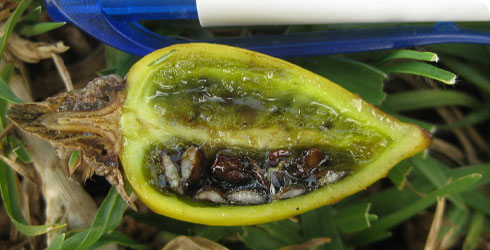Taxonomy
Morphology
Solanum phoxocarpum is a woody shrub or tree 3–6m tall, with several stems growing out of the ground.
It is covered in numerous star-shaped hairs barely visible to the naked eye, with every hair around 0.5mm wide with 11–16 side rays.
There are large curved prickles on the main stems 0.6-1.5cm long - botanically, these are called prickles rather than spines because the structure arises from the epidermis rather than from inner vascular bundles.
Leaves are 6–8cm long, dark green above and white-grey underneath.
There are 1–7 flowers in every inflorescence:
- the petals are pale purple
- the lowermost flower is 3cm diameter when fully open, larger than the others and female fertile, going on to produce fruit
- the other flowers are 1.7cm in diameter and produce functional pollen but cannot produce fruit
- the anthers are 3.5–4mm long and poricidal
Fruit is a berry with an unusual conical shape, apically pointed and retaining the same elongated pointed shape throughout development, usually 1 per infructescence, 2.8–3.7cm long. The surface of the fruit is:
- usually smooth
- shiny
- yellow when ripe, and
- sometimes has small warts
The fruits are held erect on the pedicels while they ripen, and start to hang downwards when mature. There are around 30 seeds in every berry, which are:
- 4–4.5mm long
- flat
- kidney shaped
Diagnostic description
Solanum phoxocarpum is a high-altitude species with unusual long pointy fruit, subentire leaves, and mauve flowers.
Evolution
Most members of the genus Solanum have evolved in Central and South America (Knapp 2002). Recent molecular research suggests that spiny solanums have evolved once, and within spiny solanums there was one radiation from Central and South America to Africa and Asia (Levin et al 2006, Weese and Bohs 2007).
Among the group in Africa and Asia Solanum phoxocarpum is most closely related to Solanum aculeastrum. It is likely that Solanum phoxocarpum evolved in Kenyan mountains from the same ancestors that gave rise to Solanum aculeastrum.
Look-alikes
Solanum phoxocarpum is closely related to the widespread Solanum aculeastrum, but:
- its fruit is pointy
- lacks its strongly lobed leaves on fertile branches
- the corolla is mauve rather than white
- the corolla is less dissected (the incisions between the petals are much deeper in Solanum aculeastrum)
Both species are found in the habitat mosaics characteristic of the Eastern Arc Mountains and are found growing together in woodland above 2,100m.
Some populations of Solanum aculeastrum in Uganda and the Democratic Republic of Congo have long pointed fruit like that of Solanum phoxocarpum, as well as leaves that are less lobed than average, but these leaves are not as long and thin as those of Solanum phoxocarpum and these plants have denser and longer indumentum (Vorontsova et al 2010).
